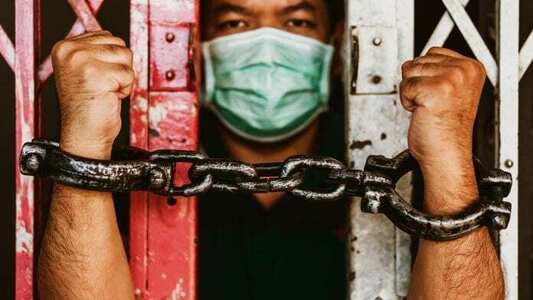25 signatures reached
To: Governor Polis
STOP COVID OUTBREAKS in Colorado Prisons!

COVID-19 Guidance for Correctional Facilities:
Administrators can plan and prepare for COVID-19 by ensuring that all persons in the facility know the symptoms of COVID-19 and the importance of reporting those symptoms if they develop. Other essential actions include developing contingency plans for reduced workforces due to absences, coordinating with public health and correctional partners, training staff on proper use of personal protective equipment (PPE) that may be needed in the course of their duties, and communicating clearly with staff and incarcerated/detained persons about these preparations and how they may temporarily alter daily life.
Communication and Coordination:
Identify points of contact in relevant state, local, tribal, and/or territorial public health departments before SARS-CoV-2 infections develop. Actively engage with the health department to understand in advance which entity has jurisdiction to implement public health control measures for COVID-19 in a particular correctional or detention facility.
Create and test communications plans to disseminate critical information to incarcerated/detained persons, staff, contractors, vendors, and visitors as the pandemic progresses.
Communicate with other correctional facilities in the same geographic area to share information including disease surveillance and absenteeism patterns among staff.
Where possible, put plans in place with other jurisdictions to prevent individuals with confirmed or suspected COVID-19 and their close contacts from being transferred between jurisdictions and facilities unless necessary for medical evaluation, medical isolation/quarantine, clinical care, extenuating security concerns, release, or to prevent overcrowding.
Stay informed about updates to CDC guidance via the CDC COVID-19 website as more information becomes known.
Review existing influenza, all-hazards, and disaster plans, and revise for COVID-19.
Train staff on the facility’s COVID-19 plan. All personnel should have a basic understanding of COVID-19, how the disease is thought to spread, what the symptoms of the disease are, and what measures are being implemented and can be taken by individuals to prevent or minimize the transmission of SARS-CoV-2.
Ensure that separate physical locations (dedicated housing areas and bathrooms) have been identified to 1) isolate individuals with confirmed COVID-19 (individually or cohorted), 2) isolate individuals with suspected COVID-19 (individually – do not cohort), and 3) quarantine close contacts of those with confirmed or suspected COVID-19 (ideally individually; cohorted if necessary). The plan should include contingencies for multiple locations if numerous infected individuals and/or close contacts are identified and require medical isolation or quarantine simultaneously. See Medical Isolation and Quarantine sections below for more detailed cohorting considerations.
Facilities without onsite healthcare capacity should make a plan for how they will ensure that individuals with suspected COVID-19 will be isolated, evaluated, tested, and provided necessary medical care.
Make a list of possible social distancing strategies that could be implemented as needed at different stages of transmission intensity.
Designate officials who will be authorized to make decisions about escalating or de-escalating response efforts as the disease transmission patterns change.
Administrators can plan and prepare for COVID-19 by ensuring that all persons in the facility know the symptoms of COVID-19 and the importance of reporting those symptoms if they develop. Other essential actions include developing contingency plans for reduced workforces due to absences, coordinating with public health and correctional partners, training staff on proper use of personal protective equipment (PPE) that may be needed in the course of their duties, and communicating clearly with staff and incarcerated/detained persons about these preparations and how they may temporarily alter daily life.
Communication and Coordination:
Identify points of contact in relevant state, local, tribal, and/or territorial public health departments before SARS-CoV-2 infections develop. Actively engage with the health department to understand in advance which entity has jurisdiction to implement public health control measures for COVID-19 in a particular correctional or detention facility.
Create and test communications plans to disseminate critical information to incarcerated/detained persons, staff, contractors, vendors, and visitors as the pandemic progresses.
Communicate with other correctional facilities in the same geographic area to share information including disease surveillance and absenteeism patterns among staff.
Where possible, put plans in place with other jurisdictions to prevent individuals with confirmed or suspected COVID-19 and their close contacts from being transferred between jurisdictions and facilities unless necessary for medical evaluation, medical isolation/quarantine, clinical care, extenuating security concerns, release, or to prevent overcrowding.
Stay informed about updates to CDC guidance via the CDC COVID-19 website as more information becomes known.
Review existing influenza, all-hazards, and disaster plans, and revise for COVID-19.
Train staff on the facility’s COVID-19 plan. All personnel should have a basic understanding of COVID-19, how the disease is thought to spread, what the symptoms of the disease are, and what measures are being implemented and can be taken by individuals to prevent or minimize the transmission of SARS-CoV-2.
Ensure that separate physical locations (dedicated housing areas and bathrooms) have been identified to 1) isolate individuals with confirmed COVID-19 (individually or cohorted), 2) isolate individuals with suspected COVID-19 (individually – do not cohort), and 3) quarantine close contacts of those with confirmed or suspected COVID-19 (ideally individually; cohorted if necessary). The plan should include contingencies for multiple locations if numerous infected individuals and/or close contacts are identified and require medical isolation or quarantine simultaneously. See Medical Isolation and Quarantine sections below for more detailed cohorting considerations.
Facilities without onsite healthcare capacity should make a plan for how they will ensure that individuals with suspected COVID-19 will be isolated, evaluated, tested, and provided necessary medical care.
Make a list of possible social distancing strategies that could be implemented as needed at different stages of transmission intensity.
Designate officials who will be authorized to make decisions about escalating or de-escalating response efforts as the disease transmission patterns change.
Why is this important?
Incarcerated Lives Matter!
